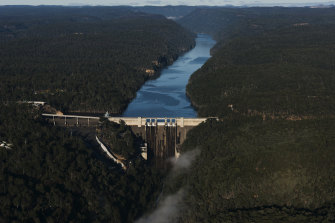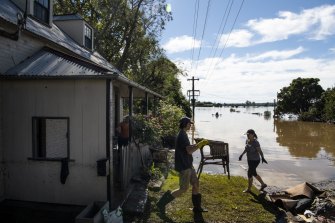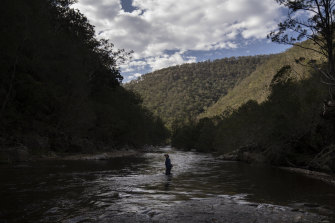Grossly under-playing Dams impact to UNESCO area differs from leaked report
A major report into the environmental impact of raising the wall of the Warragamba Dam has significantly reduced the expected toll on World Heritage bushland cited in a leaked consultant’s paper, prompting concerns over the accuracy of the study underpinning the controversial project.
The release of WaterNSW’s long-awaited environmental impact statement into the $1 billion-plus proposal to raise the walls of Sydney’s largest reservoir by up to 17 metres has drawn criticism from conservationists over the threats to endangered species, and encouragement from the property industry to build it as quickly as possible.

The report into the environmental impact of raising Warragamba Dam wall has provoked divided responses.Credit:James Brickwood
The report, released following revelations NSW Planning Minister Rob Stokes refused to declare the project essential for the state over concerns for UNESCO-protected bushland, stated about 300 hectares of the Blue Mountains World Heritage area would be impacted by raising the wall to mitigate floods downstream.
However, a draft September 2018 study conducted for SMEC consultants, the firm commissioned by WaterNSW, estimated the impacted World Heritage area would be more than four times that, at more than 1300 hectares.
Colong Foundation for Wilderness spokesman Harry Burkitt said the leaked report brought into question the underpinning validity of the entire environmental impact statement.
“It would appear that WaterNSW has redefined the impact of this proposal by grossly under-playing the extent of the World Heritage national parks and wild rivers to be inundated by this project,†he said.
The government-owned organisation has said in a statement the exhibition of the report offered the community and stakeholders “full awareness of what is proposed and an opportunity to make submissions†as part of the process, with online seminars also to be made available to the public.
“WaterNSW will provide a formal report to the NSW Department of Planning Industry and Environment in response to the submissions received,†the organisation said.
The report released on Wednesday said the project would not jeopardise the area’s World Heritage listing, and a full range of flood events were modelled to determine the likely inundation level, with peak levels for 20-year indicies used to determine the likely inundation upstream.
The report said if the dam wall was raised as proposed, the water from the March floods would have peaked 3.6 metres lower in Windsor, and about 5 metres in Penrith, two of the areas in the built-up Hawkesbury-Nepean Valley the project is hoped to benefit.

The report says raising the dam wall will lessen the impact of flooding in areas like Windsor, in the Hawkesbury-Nepean Valley.Credit:Louise Kennerley
Developer peak body, the Property Council of Australia, said when approved, the infrastructure project should be treated as a top priority, joining the Urban Development Institute of Australia, another lobby group, in calling on paused developments in the north-west growth area to be revisited.
The proposal has been wracked with controversy, with NSW Deputy Premer John Barilaro saying earlier this year he wasn’t convinced of its merits, the Insurance Council of Australia dropping its support over fears for hundreds of Aboriginal sites, and an archaeologist saying he was hired as a publicity stunt to win over traditional owners.
The report found up to 92 threatened plant and animal species “could potentially be impactedâ€, though surveys were undertaken for threatened flora at just seven locations across the Lake Burragorang area, with the report noting flora and fauna survey efforts were “less than required by the guidelinesâ€.
The critically endangered regent honeyeater and swift parrot are bird species that would be further threatened, with conservation group Birdlife Australia saying hundreds of hectares of regent honeyeater breeding habitat would be impacted.

Harry Burkitt from the Colong Foundation for Wilderness wades across part of the lower Kowmung River, an area facing inundation if the Warragamba Dam wall is raised.Credit:Wolter Peeters
“Even these findings potentially understate the impact given the threatened species surveys used in their determination were conducted prior to the devastating 2020 bushfires,†the group’s head of conservation, Samantha Vine, said.
NSW Minister for Western Sydney, Stuart Ayres, who is overseeing the proposal, said the upstream impacts of the project “must be carefully measured against the social, economic and environmental impacts flooding can have on downstream communities in western Sydney.â€
Independent NSW MLC Justin Field, who is chairing a parliamentary inquiry into the proposal, labelled the report “totally inadequateâ€, saying the voluminous study had taken several years to complete but was only open for community exhibition for 45 days.
He said there was ongoing community concern the proposal was “more about opening up parts of the floodplain to increased developmentâ€, however Mr Ayres has repeatedly refuted it would result in more land being available to develop.
The opposition’s planning, environment and heritage spokeswoman Penny Sharpe said the Labor members of the upper house inquiry into the project will use the committee to fully interrogate the EIS.
The Morning Edition newsletter is our guide to the day’s most important and interesting stories, analysis and insights. Sign up here.
0 Response to "Grossly under-playing Dams impact to UNESCO area differs from leaked report"
Post a Comment